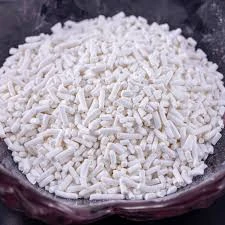
Sodium Bicarbonate and Its Role in Carbonate Chemistry and Applications
Understanding Sodium Bicarbonate and Sodium Carbonate Uses and Differences
Sodium bicarbonate and sodium carbonate are two commonly encountered chemical compounds that play vital roles in various industries and household applications. While they share similar names and certain chemical properties, they serve different purposes and have distinct characteristics. This article will explore the composition, uses, and differences between sodium bicarbonate (NaHCO₃) and sodium carbonate (Na₂CO₃), commonly known as baking soda and soda ash respectively.
Composition and Structure
Sodium bicarbonate is a white crystalline powder that presents as a mild alkaline compound. Its chemical structure consists of one sodium ion (Na⁺), one bicarbonate ion (HCO₃⁻), making it a monovalent salt. Sodium bicarbonate is well-known for its ability to react with acids, producing carbon dioxide gas, which is why it is often utilized in baking as a leavening agent. When mixed with an acidic ingredient, such as vinegar or lemon juice, it creates bubbles of carbon dioxide that help dough to rise.
On the other hand, sodium carbonate is a more robust compound, composed of two sodium ions and one carbonate ion (CO₃²⁻). Commonly referred to as soda ash or washing soda, this compound is typically found in a crystalline form or as a white powder. Sodium carbonate is a stronger alkaline substance than sodium bicarbonate, giving it a wide range of industrial applications.
Common Uses
Both compounds have diverse uses that span multiple sectors, but they are notably different in their applications.
sodium bicarbonate carbonate

Sodium Bicarbonate 1. Baking As a key ingredient in baking recipes, sodium bicarbonate releases carbon dioxide when activated by an acid, helping to leaven products such as cakes, cookies, and bread. 2. Medical Sodium bicarbonate is used in medicine to neutralize stomach acid, providing relief from heartburn and indigestion. Additionally, it is used in some emergency situations to treat acidosis. 3. Cleaning Its mild abrasive properties make sodium bicarbonate an effective cleaning agent for polishing surfaces, deodorizing refrigerators, and removing stains. 4. Personal Care Sodium bicarbonate is also found in toothpaste, deodorants, and skincare products for its exfoliating properties and ability to neutralize odors.
Sodium Carbonate 1. Household Cleaning Sodium carbonate is widely used in laundry detergents and various cleaning products due to its ability to soften water, enhancing the effectiveness of soaps and detergents. 2. Glass Production In the glass industry, sodium carbonate serves as a flux, lowering the melting point of silica during glass manufacture and reducing energy consumption. 3. Chemical Production Sodium carbonate is employed in the production of other chemicals, such as sodium bicarbonate, bleaching agents, and various dyes. 4. pH Regulation Its strong alkaline properties make sodium carbonate useful for raising the pH in swimming pools and aquariums, ensuring a balanced environment for aquatic life.
Key Differences
While both compounds contain sodium and carbonate ions, the key differences lie in their chemical properties and uses. Sodium bicarbonate has a neutral to mildly alkaline pH, making it safe for culinary and personal care applications. In contrast, sodium carbonate is highly alkaline and can be caustic in nature, requiring careful handling, especially in industrial settings.
Another significant difference is their reactivity. Sodium bicarbonate reacts with acids, producing carbon dioxide, while sodium carbonate can react with both acids and bases, functioning as a better buffering agent in chemical processes.
Conclusion
In summary, sodium bicarbonate and sodium carbonate are essential compounds with varied uses across culinary, medical, and industrial fields. Understanding their differences not only helps in selecting the appropriate compound for a specific application but also allows for safer and more effective usage. Whether it's the simple act of baking a cake or the complex processes involved in glass production, these two sodium compounds play a crucial role in our daily lives.
-
Understanding Synthetic Rubber OptionsNewsApr.27,2025
-
Trichloroisocyanuric Acid: Essential for Clean and Safe WaterNewsApr.27,2025
-
Sodium Dichloroisocyanurate: Key to Safe Water TreatmentNewsApr.27,2025
-
Sodium Acid Pyrophosphate: Essential in Modern Food ProcessingNewsApr.27,2025
-
Essential Water Treatment ChemicalsNewsApr.27,2025
-
Denatured Alcohol and Its Industrial UsesNewsApr.27,2025
-
The Versatile Uses of Sodium BicarbonateNewsApr.24,2025
Hebei Tenger Chemical Technology Co., Ltd. focuses on the chemical industry and is committed to the export service of chemical raw materials.
-

view more DiethanolisopropanolamineIn the ever-growing field of chemical solutions, diethanolisopropanolamine (DEIPA) stands out as a versatile and important compound. Due to its unique chemical structure and properties, DEIPA is of interest to various industries including construction, personal care, and agriculture. -

view more TriisopropanolamineTriisopropanolamine (TIPA) alkanol amine substance, is a kind of alcohol amine compound with amino and alcohol hydroxyl, and because of its molecules contains both amino and hydroxyl. -

view more Tetramethyl Thiuram DisulfideTetramethyl thiuram disulfide, also known as TMTD, is a white to light-yellow powder with a distinct sulfur-like odor. It is soluble in organic solvents such as benzene, acetone, and ethyl acetate, making it highly versatile for use in different formulations. TMTD is known for its excellent vulcanization acceleration properties, which makes it a key ingredient in the production of rubber products. Additionally, it acts as an effective fungicide and bactericide, making it valuable in agricultural applications. Its high purity and stability ensure consistent performance, making it a preferred choice for manufacturers across various industries.











